#indigenous peoples history of the united states
Explore tagged Tumblr posts
Text
Roxanne Dunbar-Ortiz's Indigenous Peoples' History of the United States is some fascinating history
Roxanne Dunbar-Ortiz's Indigenous Peoples' History of the United States is some fascinating history #comics #graphicnovel
In stunning full color and accessible text, a graphic adaptation of the American Book Award winning history of the United States as told from the perspective of Indigenous peoples—perfect for readers of all ages Roxanne Dunbar-Ortiz’s influential New York Times bestseller exposed the brutality of this nation’s founding and its legacy of settler-colonialism and genocide. Through evocative full…
#beacon press#featured#graphic novels#indigenous peoples history of the united states#paul pert smith#roxanne dunbar ortiz#video
0 notes
Text
What is NIBSDA?
NIBSDA was conceptualized to serve as a national digital platform and digital repository for boarding school archival collections throughout the United States. As part of truth-telling, access to boarding school records for survivors and descendants is paramount to understanding this history and its consequences on Tribal Nations. Through cultivating historical insights, NIBSDA supports community-led healing initiatives throughout American Indian and Alaska Native Nations towards restored Indigenous cultural sovereignty.
⚠ In negotiating these pursuits, you may encounter content that can trigger secondary trauma or Post Traumatic Stress Disorder (PTSD); we encourage individuals to prepare themselves prior to engaging with these collections and to seek counseling or healing if you experience any stress related to boarding school history. Indigenous peoples are warned that NIBSDA may lead to other external resources that contain images, names, and references to deceased persons. For more information, please see Content Warning. ⚠
#a friend of mine let me know this existed and i wanted to share with anyone who it might be relevant to here#indigenous#native american#ndn#boarding schools#residential schools#archives#american history#usa#united states of america#united states#indigenous peoples#indigenous history#indigenous issues#indigenous people#native americans#first nations#indigenous rights
141 notes
·
View notes
Text
youtube
Vivian Strange is reading A People's History of the United States by Howard Zinn leading up to the Presidential Election.
I read two passages in the video: a statement from Wahunsenaca (Powhatan) and a statement from Algonquian Natives from 1635.
Vivian says that she will be reading more chapters in the future and would love to have other Natives read passages in future episodes. Message me/comment here if you are interested in being apart of this project.
#vivian strange#a people's history of the united states#indigenous#ndn#native american#first nations#activism#Youtube
28 notes
·
View notes
Text

Ozaawindib is such an interesting chief, it’s a shame that we don’t have any depictions of her!
💛🏳️⚧️💛
#history#ozaawindib#ojibwe#lgbt#agokwa#native american history#historical figures#1700s#1800s#michigan#lgbt history#transgender women#united states#chief#indigenous peoples day#trans icons#mississippi river#womens history#native americans#transgender#lgbtq#henry rowe schoolcraft#american history#warrior woman#girl power#indigenous americans#historical women#nickys facts
19 notes
·
View notes
Text
youtube
#history#native americans#ndn#videos#residential schools#cultural genocide#united states#indigenous american history#american indian#indigenous peoples#indigenous history#american history#north america#Youtube
2 notes
·
View notes
Text
Flag of the Cherokee Confederacy

This is the flag of the Cherokee Confederacy. It comes from a world where the Spanish Armada successfully conquered England in 1588. While England did eventually regain its independence, the Spanish conquest severely stunted England’s growth as a world power, and lead to greater political instability. As a result, England never became a demographic juggernaut during the colonization of North America. The lands that would have become the Thirteen Colonies are a patchwork of nations and colonies founded by numerous European nations. There are also several independent indigenous nations, such as the Cherokee Confederacy.
The Cherokee Confederacy also includes the Muskogee, Chickasaw, and Choctaw tribes. The Cherokee, as reflected by the name, were the founding tribe of the confederacy. The Cherokee Confederacy was one of the first indigenous nations of North America to implement westernization and industrialization programs. Today, most Cherokee dress in European-style clothing, but do wear traditional clothing on special occasions. Like most southern nations in eastern North America, the Cherokee historically practiced slavery. Slavery was formally abolished in 1885 as part of the modernization efforts. Racial divides and tensions still remain, but the Cherokee government has, in recent years, implement programs to help blacks integrate into Cherokee society.
The Cherokee legislature, known as the Tribal Council, is organized into a semi-parliamentary democracy, with a prime minister as the Head of Government, and a president as Head of State. The Cherokee Tribal Council is closer in style to the French National Assmbly, rather than to the English Parliament. The Cherokee Confederacy is centered around what would be western North Carolina, Tennessee, and the northern bits of Alabama, Mississippi, and Georgia. The indigenous republics of North America, being sovereign nations, did not suffer an equivalent of the Indian Removal Act.
Historically, the Cherokee Confederacy has been rivals with the Haudenosaunee Federation. However, in recent times the two nations have been putting their rivalries behind them. In terms of good relations, the Cherokee Confederacy has historically been an ally of New Neatherlands, which in located in Virginia. The various nations of North America have formed a European Union-style economic union, and there are hopes that this will eventually leads to a federation. There is a general spirit of good will and optimism. That said, North America still has a ways to go before its nation states become united.
The flag contains seven gold stars in the shape of the Big Dipper, or Ursa Major, on an orange field with a green border. Ursa Major is an important constellation to several tribes within the Cherokee Confederacy. It also symbolizes how the same night sky shine over the entire Cherokee Confederacy. Blue would seem a natural color choice, but the Cherokee picked orange instead. There is some debate about why this is. Popular belief says that it symbolizes the Cherokee Confederacy’s ties to New Netherlands. However, the Cherokee actually picked orange to contrast with the blue flags several other North American nations use. The green border is to offset the orange.
Link to the original flag on my blog: https://drakoniandgriffalco.blogspot.com/2022/05/flag-of-cherokee-confederacy.html?m=1
#alternate history#alternate history flag#alternate history flags#flag#flags#vexillology#Cherokee#Cherokee Confederacy#Creek#muskogee#chickasaw#Five Civilized Tribes#Choctaw#indigenous people#Native Americans#Native American#indigenous#north america#United States#America#USA#United States of America#alt history
37 notes
·
View notes
Text

#imperialism#colonialism#aboriginal people#aboriginal indians#indigenous#blaxploitation#black people gettin exploited#black history is world history#eugenics#replace white supremacy#dr neely fuller jr#dr ivan van sertima#dr amos wilson#dr frances cress welsing#dr martin luther the king#dr joy degruy#black panther party for self defense#olmecs#moors#jarawa people#melanin#blacknificent#cointelpro#queen nanny maroons#black man black woman black child#united states of africa#black economics#blackamoor#melanesia#black owned stores
5 notes
·
View notes
Text
ok so i'm gonna say something controversial
voting. i'm probably still gonna do it this election if i'm given the opportunity (i don't have reliable transportation to polling locations), so don't get mad at me. but like. the vote blue no matter who crowd is.. a bit concerning? people are blaming the average voter for the 2016 election not being a win for democrats, but if i recall correctly, hillary won the popular vote. the only reason trump won was because the electoral college voted for trump, which happened because of swing state loopholes. the conditions we're in right now are not uniquely unprecedented. project 2025 is not going to be stopped by kamala being president. after all, biden being in office didn't stop roe v wade from being overturned, and a lot of the promises of the 2020 biden campaign have fallen through. i don't think it's "doomerposting" or whatever to point any of this out, and i think it's obtuse to pretend like even if dems win this election any of the terrible shit that's being cooked up is going to be prevented.
i find it concerning that people are calling other people selfish and saying they don't care about ""harm reduction"" when they point out that voting is pretty much the thoughts and prayers of leftist action. i find it concerning that people are saying that this is unprecedented and has never happened before, and then coincidentally have never read up on US history outside of what they were taught in high school. i am begging you all to read up, become informed, and hopefully come back with a mindset of community work. no offense, but if you think that voting is the end all be all, i do not think you have read up on US history.
my point is not that you shouldn't vote, just like i wouldn't say you shouldn't think or pray about something. but please, PLEASE, add more to your roster of political activism than putting in a ticket to the polling booth. if you're not sure where to start on us history, i would recommend starting with a people's history of the united states, then go through beacon press's revisioning united states history series, and then go from there. there are free copies of those books/audiobooks online, they're not hard to find. you will learn so much about historical precedent, historical action, and historical community, and i promise that you will not regret learning more.
voting is not the end all be all, and it has never been. anyone who tries to convince you that it is the end all be all is either misinformed or has ulterior motives.
i promise you that you are not the only one that feels upset about the way things are right now. remember: strength in numbers.
#ramble#voting#us politics#i am once again begging you to read a people's history of the united states#i'm currently on my second read of aphus and i'm doing annotations and stuff#cross referencing it with an indigenous peoples history of the united states#i want to make some sort of compiled version that has each different perspective#but that would be. a lot.#every time a white moderate says that trump is the worst president in us history an angel loses its wings#honey they're all the worst president#there is no good president.#there are good peoples organizations though#there are good activist groups. good community pantries. good causes. but you're not gonna find those in the corporate political parties.
3 notes
·
View notes
Text










Star-Spangled History Lessons, Pt.2
#united front#meme#memes#united states of america#usa#america#america is bad#american history#history#civil war#native americans#indigenous peoples#genocide#battle of blair mountain#redneck
6 notes
·
View notes
Text
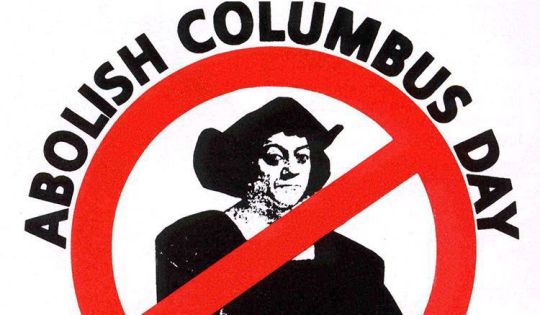
A Proclamation on Indigenous Peoples’ Day, 2021
Since time immemorial, American Indians, Alaska Natives, and Native Hawaiians have built vibrant and diverse cultures — safeguarding land, language, spirit, knowledge, and tradition across the generations. On Indigenous Peoples’ Day, our Nation celebrates the invaluable contributions and resilience of Indigenous peoples, recognizes their inherent sovereignty, and commits to honoring the Federal Government’s trust and treaty obligations to Tribal Nations.
Our country was conceived on a promise of equality and opportunity for all people — a promise that, despite the extraordinary progress we have made through the years, we have never fully lived up to. That is especially true when it comes to upholding the rights and dignity of the Indigenous people who were here long before colonization of the Americas began. For generations, Federal policies systematically sought to assimilate and displace Native people and eradicate Native cultures. Today, we recognize Indigenous peoples’ resilience and strength as well as the immeasurable positive impact that they have made on every aspect of American society. We also recommit to supporting a new, brighter future of promise and equity for Tribal Nations — a future grounded in Tribal sovereignty and respect for the human rights of Indigenous people in the Americas and around the world.
In the first week of my Administration, I issued a memorandum reaffirming our Nation’s solemn trust and treaty obligations to American Indian and Alaska Native Tribal Nations and directed the heads of executive departments and agencies to engage in regular, meaningful, and robust consultation with Tribal officials. It is a priority of my Administration to make respect for Tribal sovereignty and self-governance the cornerstone of Federal Indian policy. History demonstrates that Native American people — and our Nation as a whole — are best served when Tribal governments are empowered to lead their communities and when Federal officials listen to and work together with Tribal leaders when formulating Federal policy that affects Tribal Nations.
The contributions that Indigenous peoples have made throughout history — in public service, entrepreneurship, scholarship, the arts, and countless other fields — are integral to our Nation, our culture, and our society. Indigenous peoples have served, and continue to serve, in the United States Armed Forces with distinction and honor — at one of the highest rates of any group — defending our security every day. And Native Americans have been on the front lines of the COVID-19 pandemic, working essential jobs and carrying us through our gravest moments. Further, in recognition that the pandemic has harmed Indigenous peoples at an alarming and disproportionate rate, Native communities have led the way in connecting people with vaccination, boasting some of the highest rates of any racial or ethnic group.
The Federal Government has a solemn obligation to lift up and invest in the future of Indigenous people and empower Tribal Nations to govern their own communities and make their own decisions. We must never forget the centuries-long campaign of violence, displacement, assimilation, and terror wrought upon Native communities and Tribal Nations throughout our country. Today, we acknowledge the significant sacrifices made by Native peoples to this country — and recognize their many ongoing contributions to our Nation.
On Indigenous Peoples’ Day, we honor America’s first inhabitants and the Tribal Nations that continue to thrive today. I encourage everyone to celebrate and recognize the many Indigenous communities and cultures that make up our great country.
NOW, THEREFORE, I, JOSEPH R. BIDEN JR., President of the United States of America, do hereby proclaim October 11, 2021, as Indigenous Peoples’ Day. I call upon the people of the United States to observe this day with appropriate ceremonies and activities. I also direct that the flag of the United States be displayed on all public buildings on the appointed day in honor of our diverse history and the Indigenous peoples who contribute to shaping this Nation.
IN WITNESS WHEREOF, I have hereunto set my hand this eighth day of October, in the year of our Lord two thousand twenty-one, and of the Independence of the United States of America the two hundred and forty-sixth.
#joe biden#indigenous peoples day#US politics#US history#fuck christopher columbus#USA#united states of america
10 notes
·
View notes
Text

"Hardy Women Warriors Inherit Skill, Stamina of Ancestors," Toronto Star. October 30, 1943. Page 2. --- ADVANTAGE of inherited ability is held by Private Minnie Spotted Wolf, when she picks up a bow and arrow on the archery range at the New River, N.C., army camp.
OF A SEAFARING RACE, these Norwegian "Wrens" were right at home during recent exercises taken aboard the destroyer Glaisdale, and none complained of sea-sickness.
#minnie spotted-wolf#wrens#royal norwegian navy#united states marine corps#world war ii#women at war#women in uniform#blackfoot confederacy#siksika#american indians#indigenous people#indigenous history
5 notes
·
View notes
Text
IN JULY 1980, just outside Bakersfield, California, the body of a woman who had been stabbed 27 times was found dumped in an almond orchard. She carried no identification, and Kern County detectives could not match her fingerprints with anyone, though they thought she might be Native American. The autopsy showed she had previously given birth and that she’d been sexually assaulted before her death. She had two tattoos: a rose surrounded by the words “Mother I love you,” and a heart with the words “Seattle” and “Shirley.” This particular “Jane Doe” was part of a horrific pattern: Throughout North America, Indigenous women, girls, and two-spirit, trans and queer people are being murdered and disappearing altogether. According to a 2016 study funded by the National Institute of Justice, four in five American Indian and Alaska Native women in the U.S. have experienced violence. In Canada, Indigenous women and girls are 12 times more likely to experience violence than non-Indigenous women.
Canada held a three-year federally mandated investigation, the National Inquiry into Missing and Murdered Indigenous Women and Girls (MMIWG). The final report, from 2019, acknowledged that “there is not an empirically reliable estimate of the number of missing and murdered Indigenous women and girls in Canada” but concluded that it constituted a “genocide”. Advocates estimate that the number of cases is on the order of 4,000; meanwhile, a count in 2014 by the Royal Canadian Mounted Police (RCMP) — one of Canada’s largest policing agencies — tallied only 1,181 cases during a 32-year span.
Even with the RCMP’s lower estimate, Indigenous people account for 25% of Canada’s homicide victims between 2015-2020, despite comprising only about 5% of the country’s population. These statistics, already a decade old, appear to be the most recent of their kind reported by RCMP.
The National Inquiry was clear about the root causes of the epidemic: colonial structures, including the Indian Act; the removal of Indigenous children from their homes; forced attendance at residential schools and breaches of Indigenous rights, all of which directly resulted in increased rates of violence, death and suicide in Indigenous communities.
Of the 1,181 cases that the RCMP acknowledged, 225 remained unsolved as of 2013. For family members, the response is slow and disappointing. In Canada, 91% of homicides involving non-Indigenous women are likely to be solved, compared to just 77% for Indigenous women. The crisis is similar in the U.S. According to the FBI’s National Crime Information Center, more than 5,700 American Indian and Alaska Native women and girls were reported missing in 2016, and advocates believe the number could be even higher, given that authorities sometimes think victims are Latina or white.
A 2008 study funded by the U.S. Department of Justice found that women on some reservations are killed at a rate more than 10 times the national average. The U.S Department of the Interior told HCN that they did not have any additional information about the percentage of cases solved relating to Indigenous women and girls.
In response to families’ demand for justice and attention to the crisis, Canada and the U.S. have developed initiatives both within and across their own borders. In the U.S. in 2021, Interior Secretary Deb Haaland (Laguna Pueblo) announced the creation of the Missing and Murdered Unit (MMU) inside the Bureau of Indian Affairs Office of Justice Services to address MMIWG cases and strengthen law enforcement’s resources. According to the Department of the Interior, the initiative’s funding level has grown from $5.5 million to $16.5 million over fiscal year 2020 through 2022. The fiscal year 2023 Omnibus Appropriations bill maintained Bureau of Indian Affairs MMIP funding at $16.5 million.
In Canada, the response to MMIWG cases has been fragmented. The Tyee reported in 2021 that the RCMP, Canada’s national police force, lacked a coordinated strategy, while the regular police force does not separately track MMIWG cases. A few months later, Canada launched a national action plan to address MMIWG cases.
Throughout North America, families have waited decades for information. “Every family that we heard from was waiting, waiting for an answer,” said Marion Buller, who is Cree and a member of Mistawasis First Nation as well as the chief commissioner of Canada's National Inquiry. “They were prepared for bad news and good news.
“A loved one was murdered or went missing 20, 30 or 40 years ago, and they were still waiting for something,” she continued. “They have not given up hope.”
According to Buller, people are not generally concerned with issues of privacy when they have been waiting so long; at this point, they're simply desperate to find their loved ones. “Some families would very willingly provide samples of their own DNA if that would somehow identify a lost loved one’s remains or provide a lead to locating their lost loved one,” Buller said, adding that she had heard from families who had made this offer to law enforcement and been turned down.
— New DNA technique could bring closure for families of missing and murdered Indigenous people
#martha troian#hilary beaumont#new dna technique could bring closure for families of missing and murdered indigenous people#history#current events#racism#colonialism#misogyny#feminism#crime#law enforcement#police#child welfare#genetics#national inquiry into missing and murdered indigenous women and girls#indian act#first nations#native americans#cree#mistawasis nêhiyawak#canada#usa#alaska#shirley soosay#deb haaland#marion buller#united states department of justice#national institute of justice#bureau of indian affairs#missing and murdered indigenous women and girls
1 note
·
View note
Text
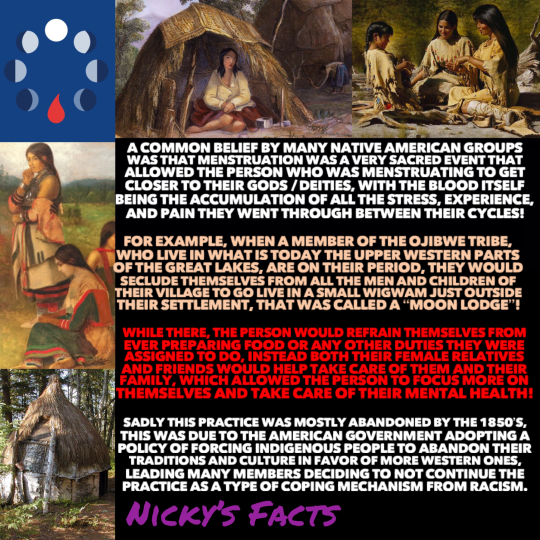
By providing the proper care for women and those who menstruate, whether it traditional or modern, empower them with the confidence and support that they need!
🩸
#history#menstruation#ojibwe#moon lodge#mental health#indigenous history#great lakes#period health#united states#native american#women empowerment#femininity#menstruation history#people who menstruate#womens health#menstrual care#womens history#indigenous americans#traditional practices#period cramps#american history#indigenous culture#menstrual health#menstrual cycle#native american history#nickys facts
33 notes
·
View notes
Text
Ruin Their Crops on the Ground: The Politics of Food in the United States, from the Trail of Tears to School Lunch - US

The first and definitive history of the use of food in United States law and politics as a weapon of conquest and control, a Fast Food Nation for the Black Lives Matter era
#trail of tears#school lunch#american history#food#american politics#racism in history#racism#indigenous history#indigenous peoples#racism in politics#bigotry#nonfiction#nonfiction books#book cover#book covers#the united states of america#united states#american covers
1 note
·
View note
Text
does anyone have nonfiction book recommendations....idc what its about if i dont learn more stuff im gonna die
#im abt halfway through an indigenous people's history of the united states. and i have braiding sweet grass on my shelf rn#i desperately want to start taking classes again but cant afford it so. i shall read at my library instead HKJFHDKJFSKJDF
1 note
·
View note
Text
Washitaw Dugdumoundya - go see for yourself
information for the public about the Nation of people who are indigenous to the American continent. Many people are unaware that this Nation of people even exists at all. We are a multicultural, highly spiritual nation of aboriginal, indigenous Americans who were originally called Washitaw Mu’urs (or Ouachita as it was amended by others throughout our history). We accept both lineal and non-lineal citizens into our Nation. We DO NOT discriminate based on race or religion, as this is the heart of God and of our current Empress, Her Highness, Verdiacee “Tiari” Washitaw-Tunica (Turner) Goston El Bey. Her Highness Previous Spiritual Advisor of Spiritual Education and Information of the Ministry, Oukhara Zeshera, states No Longer Advisor), “All of us within our nation are creations of the Divine Creator, and we are all our Brothers and Sisters. We need to learn our past spirituality, so we can build as a nation. Remember, the first principle in Washitaw is LOVE!”
Imperial Royal Court French & Spanish “The Washitaw de Dugdahmoundyah was recorded as The Oldest Indigenous People on Earth in the final list of all attendees.”
In 1993, The Washitaw Indigenous Nation of Mound Builders received its United Nations number: 215/93. To date, the Empress, as one of the living heirs of Henry Turner, has recovered the title to 68,883 acres of land comprising most of the northern part of the ‘said state of Louisiana. The Washitaw never drew boundaries, We are the original inhabitants of all the lands from wherever you find mound sites you find part of the Empire in so called north America
( A-Meri- Ta ). The one letter rule change one letter to hide the truth they change the letter ” T ” into “C” from Meri-Ta, to A-meri-ca.
The area from Alleghenies to the Rocky Mountains, from Canada down to the Gulphe of Mexico, including East and west Floridaes: and the Pecos River, encompasses the domain of the Empire Washitaw de Dugdahmoundyah. A land mass over 30 million acres. This is one of the regions that the United States claim as part of the Louisiana Purchase.It’s the same region Abraham Lincoln coined as, The Egypt of the West.
The Ancient and Medieval American Mississippian culture 500-1500 AD
Going down a deep dive of the Mississippian mound culture of precolumbian United States.
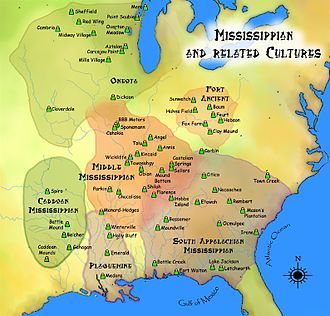
I knew some stuff about the topic, pretty basic and precursory information, but now I think I'm gonna do some more in depth research. It's just fascinating to learn how throughout the Mississippi river region and deep south there were large cities that rivaled medieval cities in Europe with populations in the tens of thousands. Cahokia Illinois for example.
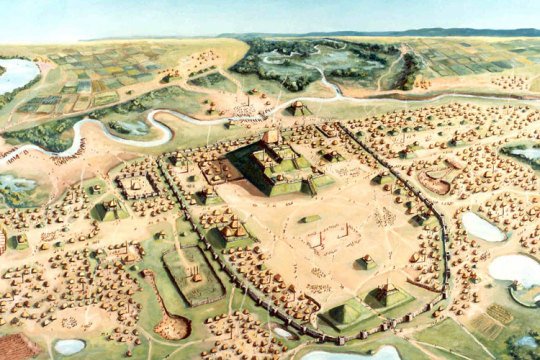

And they made all kinds of really cool artifacts
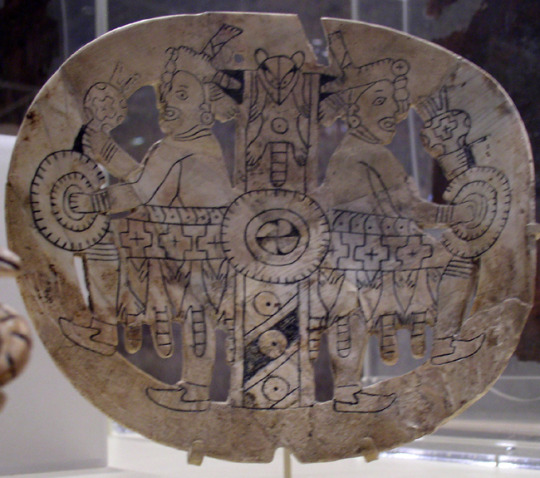
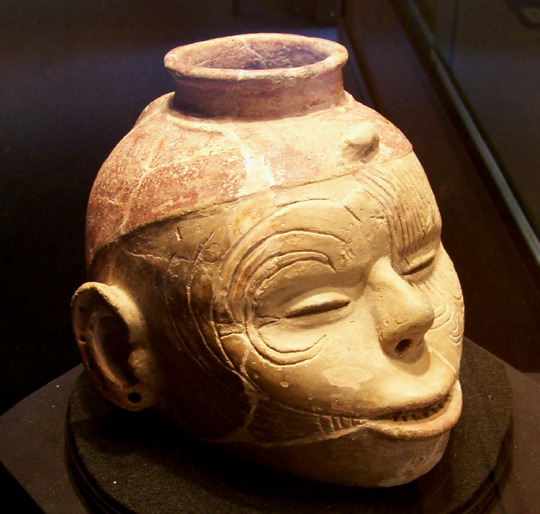
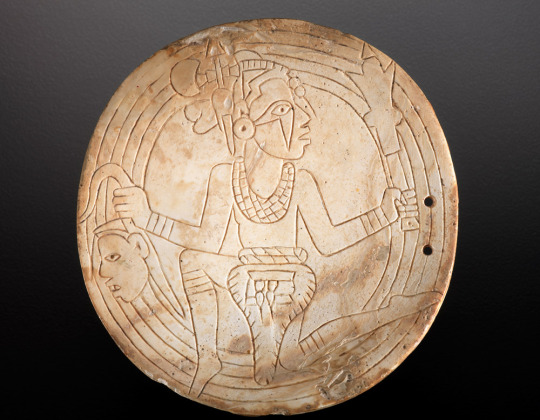
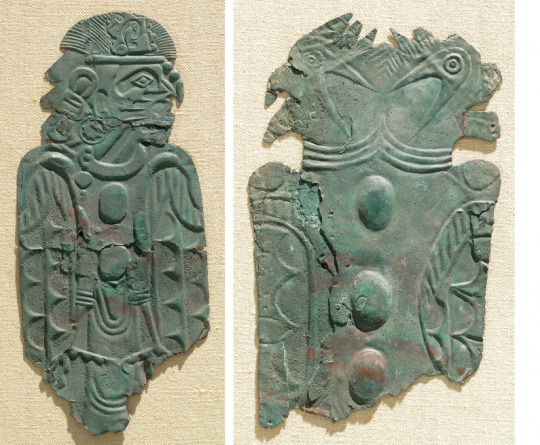
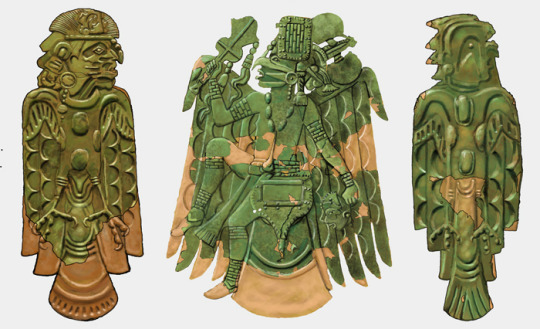
They had trade routes all over North America. For example copper from the Great Lakes region, shells from the Atlantic and Gulf Coast, and Obsidian from Mexico. In addition their own goods have been found exported to archaeological sites all over North America.
Then around the 14th century the Little Ice Age started, which was basically a sudden drop in global temperatures lasting until the mid 19th century, which resulted in crop failures and famine worldwide. In addition large populations were already stretching the food resources and agriculture of the area. This resulted in the decline of urban culture among the Mississippians. At the time in Eurasia the same was happening, which helped bring about the Black Death. So there were hard times all around. The 14th century was a bad time to be alive almost everywhere. Final collapse occurred in the 16th century when smallpox swept through the Americas after European contact.
Unfortunately for us they had no system of writing, at least none that can be found. So we will probably never know their story and history as well as say the ancient Romans. All that we know is pieced together through archaeological findings and oral history of their modern descendants.
Anyway I'm gonna find some good audiobooks to listen to on the subject while I do my weightlifting.
#information for the public about the Nation of people who are indigenous to the American continent. Many people are unaware that this Nation#highly spiritual nation of aboriginal#indigenous Americans who were originally called Washitaw Mu’urs (or Ouachita as it was amended by others throughout our history). We accept#as this is the heart of God and of our current Empress#Her Highness#Verdiacee “Tiari” Washitaw-Tunica (Turner) Goston El Bey. Her Highness Previous Spiritual Advisor of Spiritual Education and Information of#Oukhara Zeshera#states No Longer Advisor)#“All of us within our nation are creations of the Divine Creator#Imperial Royal Court French & Spanish “The Washitaw de Dugdahmoundyah was recorded as The Oldest Indigenous People on Earth in the final li#The Washitaw Indigenous Nation of Mound Builders received its United Nations number: 215/93. To date#the Empress#as one of the living heirs of Henry Turner#has recovered the title to 68#883 acres of land comprising most of the northern part of the ‘said state of Louisiana. The Washitaw never drew boundaries#We are the original inhabitants of all the lands from wherever you find mound sites you find part of the Empire in so called north America#to A-meri-ca.#including East and west Floridaes: and the Pecos River#encompasses the domain of the Empire Washitaw de Dugdahmoundyah. A land mass over 30 million acres. This is one of the regions that the Uni#Washitaw Dugdumoundya
352 notes
·
View notes